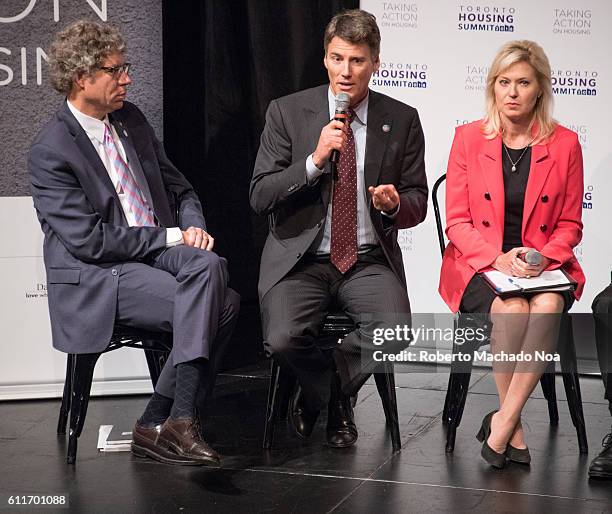How To Make Housing Affordable Without Crashing Home Prices: Insights From Gregor Robertson

Table of Contents
Increasing Housing Supply
A core tenet of making housing affordable is increasing the overall supply to meet demand. Simply put, more homes mean lower prices. Addressing the affordable housing crisis requires a significant expansion of housing options across all price points. This isn't just about building more homes; it's about building the right homes in the right places.
Zoning Reform and Density Initiatives
Outdated zoning regulations often restrict the construction of multi-family dwellings and higher-density housing, contributing to a shortage of affordable housing units. Relaxing these restrictions can significantly increase the number of available units and improve affordability.
- Rezoning single-family areas: Allowing duplexes, triplexes, and townhouses in traditionally single-family zones can dramatically increase housing density and supply. This approach is crucial for increasing the stock of affordable homes in established neighborhoods.
- Inclusionary zoning policies: Mandating a percentage of affordable units in new developments ensures that a portion of new construction directly addresses the need for affordable housing options. This strategy creates a diverse range of housing options within new developments.
- Streamlining permitting processes: Reducing bureaucratic hurdles and delays in the permitting process can significantly reduce construction costs and accelerate the creation of new affordable housing. Efficiency in permitting is key for increasing the supply of affordable homes quickly.
- Innovative housing models: Exploring models like accessory dwelling units (ADUs) – also known as granny flats – and co-housing communities can create additional housing options on existing lots, increasing density without significantly altering the character of neighborhoods. These options are crucial for maximizing existing land for more affordable housing solutions.
Incentivizing Housing Development
Governments can play a crucial role in incentivizing developers to build more affordable housing by offering financial and regulatory support. This can bridge the gap between market-rate development and the creation of truly affordable homes.
- Tax abatements: Offering tax breaks for affordable housing projects reduces the financial burden on developers, making such projects more attractive and financially viable. These incentives can be targeted towards specific areas or types of affordable housing projects to address local needs.
- Infrastructure grants: Providing grants for infrastructure improvements in areas targeted for development reduces development costs and encourages investment in previously underserved areas. This is essential for making these areas attractive for affordable housing projects and residents.
- Fast-track permitting: Creating expedited permitting processes specifically for affordable housing projects can significantly reduce construction timelines and overall costs. This streamlines the process, allowing for quicker creation of much-needed affordable housing.
- Public-private partnerships: Partnering with the private sector leverages their expertise and resources to create more efficient and effective affordable housing projects. Collaborative efforts are essential for tackling the complexity of the affordable housing crisis effectively.
Addressing Demand-Side Factors
While increasing supply is crucial, managing demand is also essential to prevent price volatility and ensure affordable housing remains accessible. Addressing factors influencing demand can help stabilize the market and prevent excessive price increases.
Investing in Public Transportation and Infrastructure
Improved access to public transportation and essential services reduces reliance on car ownership, making areas outside of expensive city centers more attractive and affordable. This reduces the demand for housing in the most expensive areas, helping spread demand and stabilize prices.
- Expanding public transit: Investing in bus rapid transit and light rail systems expands access to employment and essential services, reducing the need to live in close proximity to the city center. This makes areas with more affordable housing more accessible.
- Improving cycling infrastructure: Dedicated bike lanes and secure bike storage create safer and more convenient cycling options, making commuting more accessible and reducing transportation costs.
- Enhancing pedestrian walkways: Improving pedestrian walkways and accessibility for people with disabilities makes areas more attractive for all residents, regardless of their mode of transportation.
Supporting Rent Control and Tenant Protections
While controversial, carefully designed rent control measures can help prevent excessive rent increases and protect vulnerable tenants. However, it's crucial to implement these measures strategically to avoid unintended consequences.
- Strategic rent control: Implementing rent control with built-in mechanisms to avoid unintended consequences, such as limiting rent increases to inflation rates or exempting new constructions, is key.
- Strengthening tenant protections: Robust tenant protections prevent unjust evictions and unfair rental practices, ensuring tenant security and stability.
- Rental assistance programs: Providing rental assistance programs for low-income families directly addresses the affordability challenges faced by many vulnerable households.
Innovative Financing and Investment Strategies
Exploring alternative financing models can inject much-needed capital into affordable housing initiatives. These strategies can make affordable housing projects more financially viable and increase the overall supply of affordable homes.
Community Land Trusts (CLTs)
Community Land Trusts (CLTs) are non-profit organizations that acquire land and build affordable homes, ensuring long-term affordability by separating land ownership from home ownership. This innovative model keeps housing permanently affordable, protecting residents from rising land values.
- Supporting CLT growth: Providing funding and resources to support the establishment and growth of Community Land Trusts is crucial for expanding their impact.
- Educating the public: Educating the public about the benefits of Community Land Trusts increases their adoption and support, fostering wider community engagement.
Government-Backed Loans and Subsidies
Government-backed loans and subsidies can reduce the cost of financing for both developers and homebuyers, making affordable housing more accessible. These financial incentives can significantly reduce barriers to affordable homeownership.
- Expanding loan access: Expanding access to government-backed loans for affordable housing projects makes these ventures more attractive for developers.
- Mortgage payment subsidies: Offering subsidies to reduce the monthly mortgage payments for low-income families directly increases the affordability of homeownership.
- Innovative financing programs: Creating innovative financing programs that leverage private capital for affordable housing leverages public funds more effectively and increases overall investment in affordable housing.
Conclusion
Making housing affordable without destabilizing the market requires a multifaceted approach. By combining increased housing supply through zoning reform and incentivized development with demand-side strategies that manage affordability and invest in community infrastructure, coupled with innovative financing mechanisms, we can create a sustainable path towards homeownership for all. Gregor Robertson's insights highlight the importance of a holistic strategy that considers all aspects of the housing market. Let's work together to implement these solutions and create truly affordable housing for everyone – building a future where the dream of homeownership is within reach. Let's discuss how to make affordable housing a reality for all.

Featured Posts
-
 Link Live Streaming Moto Gp Inggris 2025 Saksikan Sprint Race Pukul 20 00 Wib
May 26, 2025
Link Live Streaming Moto Gp Inggris 2025 Saksikan Sprint Race Pukul 20 00 Wib
May 26, 2025 -
 Jadwal Moto Gp Inggris 2025 Hari Tanggal And Jam Tayang
May 26, 2025
Jadwal Moto Gp Inggris 2025 Hari Tanggal And Jam Tayang
May 26, 2025 -
 The Rise Of Alternative Delivery Options In Canada A Response To Canada Post Issues
May 26, 2025
The Rise Of Alternative Delivery Options In Canada A Response To Canada Post Issues
May 26, 2025 -
 Thierry Ardisson Accusations De Sexisme Et Repercussions Sur Sa Carriere
May 26, 2025
Thierry Ardisson Accusations De Sexisme Et Repercussions Sur Sa Carriere
May 26, 2025 -
 Perubahan Klasemen Moto Gp Setelah Kemenangan Sprint Race Marc Marquez Di Argentina 2025
May 26, 2025
Perubahan Klasemen Moto Gp Setelah Kemenangan Sprint Race Marc Marquez Di Argentina 2025
May 26, 2025
